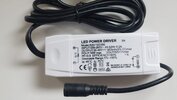Hi all, I hope somebody can help me on non-functioning domestic LED lighting issues.
We had a full house rewire about 18months ago as part of a renovation. We installed LED's downlights at the same time, each using its own individual 12V transformer. The transformers connect to each LED unit via a short cable with a keyed connector. The transformers sit in the ceiling space next to the LED's . All lighting circuits were working. A few months back I removed some switch plates and LED downlights for access to patch/fill/paint the ceiling and wall plasterwork. This involved disconnecting wiring from the plates, and unplugging DL’s from the 12 transformers. The transformer input wiring was not disconnected. Now, the switch plates have been reconnected and LEDs put back, but two DL’s are not working. The two units in question are on separate circuits;
DL1 - is on two-way switches
DL2 - is three-way switches
I can only surmise an error in re-connecting the switch plate wiring, despite noting where each wire was originally connected. I have used a voltage tester pen to confirm the DL1 & DL2 transformer brown input wires are made ‘live’ when using their respective switches. I have swapped the DL’s around with known working units but this has no effect.
Any ideas or suggestion on what further checks I could make are most welcomed.
We had a full house rewire about 18months ago as part of a renovation. We installed LED's downlights at the same time, each using its own individual 12V transformer. The transformers connect to each LED unit via a short cable with a keyed connector. The transformers sit in the ceiling space next to the LED's . All lighting circuits were working. A few months back I removed some switch plates and LED downlights for access to patch/fill/paint the ceiling and wall plasterwork. This involved disconnecting wiring from the plates, and unplugging DL’s from the 12 transformers. The transformer input wiring was not disconnected. Now, the switch plates have been reconnected and LEDs put back, but two DL’s are not working. The two units in question are on separate circuits;
DL1 - is on two-way switches
DL2 - is three-way switches
I can only surmise an error in re-connecting the switch plate wiring, despite noting where each wire was originally connected. I have used a voltage tester pen to confirm the DL1 & DL2 transformer brown input wires are made ‘live’ when using their respective switches. I have swapped the DL’s around with known working units but this has no effect.
Any ideas or suggestion on what further checks I could make are most welcomed.



